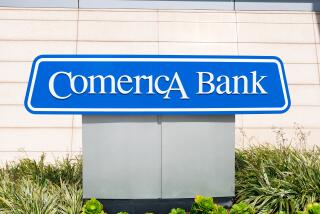FDIC reports bank earnings down sharply
- Share via
U.S. bank and thrift earnings dropped to their lowest level since 1991 in the fourth quarter, hurt by trading losses and increased reserves for bad loans, the Federal Deposit Insurance Corp. said Tuesday.
Net income for FDIC-insured institutions was $5.82 billion, an 83% decline from the $35.2 billion reported in the fourth quarter of 2006, the regulator said in its quarterly report on the banking industry.
“Weakness in the housing sector and the credit squeeze in financial markets made it a very challenging time,” FDIC Chairman Sheila Bair said. “We can expect these problems to continue throughout 2008.”
The world’s largest banks and securities firms have announced $163 billion in asset write-downs and credit losses since the beginning of 2007. The charges stem from the collapse of the U.S. sub-prime mortgage market amid the biggest housing slump in a quarter-century.
Six large lenders accounted for more than half of the year-over-year drop in quarterly net income, the FDIC said.
Funds set aside to cover loan losses grew the most in 20 years to a record $31.3 billion, an increase from $16.7 billion in the third quarter.
Loans delinquent 90 days or more increased the most in the 24 years FDIC-insured institutions have reported the information, making up 1.4% of the industry’s loans at the end of the fourth quarter, the FDIC said.
Still, an “overwhelming majority” of banks and thrifts remain well-capitalized and profitable, and “are successfully coping with the challenges they face,” Bair said. Nearly 90% of lenders were profitable last year and 99% had sufficient capital at the end of the year, she said.
The FDIC plans to “keep a close eye” on loan portfolios beyond housing, including credit cards, commercial real estate and small business, Bair said.
“All of these are showing signs of stress, as weakness in the housing market continues,” Bair said.
Lenders with assets concentrated in commercial real estate, a high-risk area, are under scrutiny, said John Corston, the FDIC’s associate director of large bank supervision.
“The way a lot of these credits are structured, it will take a while for problems to begin to show up on the financial performance of the institutions,” Corston said.
Regulators have warned lenders with assets concentrated in commercial real estate to take extra precautions against potential losses.
More to Read
Inside the business of entertainment
The Wide Shot brings you news, analysis and insights on everything from streaming wars to production — and what it all means for the future.
You may occasionally receive promotional content from the Los Angeles Times.









